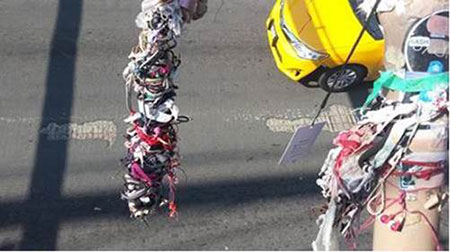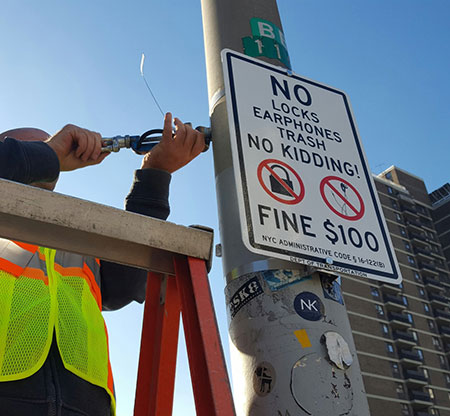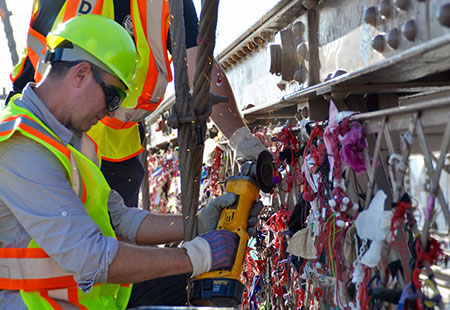Press Releases
FOR IMMEDIATE RELEASE
Press Release #16-096
Friday, October 7, 2016
Scott Gastel/Gloria Chin (212)839-4850
Along Brooklyn Bridge Promenade, NYC DOT Cuts Off “Love Locks,” Announces New Signage and Fine Enforcement on New York City Landmark
New “No Locks” signs inform visitors of a $100 fine; thousands of padlocks are attached to the bridge’s central span every year, creating new maintenance costs and endangering vehicular traffic below
DOT sends letters to tour books asking for their assistance in changing tourist behavior
New York City Department of Transportation Commissioner Polly Trottenberg today announced that New York City had undertaken its first coordinated effort to curb the practice of so-called “love locks” being left on the Brooklyn Bridge. Over the last decade, visitors have attached a growing number of padlocks to the bridge’s pedestrian promenade, creating new maintenance costs and endangering vehicular traffic below. Commissioner Trottenberg was joined today by senior officials from the NYPD, the Landmarks Preservation Commission and NYC & Company.
“A walk on the Brooklyn Bridge can be one of the most beautiful and romantic anywhere in the world,” said Commissioner Trottenberg. “However, with the bridge now loaded with so-called ‘love locks,’ we face costly maintenance headaches and serious potential dangers for car traffic. While we welcome and appreciate the enthusiasm of couples sharing the walk on this New York City landmark, we ask that they abide by a variation of a maxim heard in our national parks: ‘take nothing but selfies, leave nothing but footprints.’”
“The brilliant architect John Roebling designed the Brooklyn Bridge to be a safe structure that would endure for centuries, but these ‘love locks’ pose a danger to pedestrians and motorists by adding stress to the bridge’s structure,” said NYPD Transportation Bureau Chief Thomas M. Chan. “We encourage romantics to continue to express their love but avoid the heartache of a summons.”
“I commend the Department of Transportation’s proactive approach to protecting the Brooklyn Bridge, a New York City Landmark, and one of the most iconic suspension bridges in the world,” said Commissioner Meenakshi Srinivasan, Chair of the Landmarks Preservation Commission. “The Brooklyn Bridge is treasured for its singular beauty, its architectural expression, and significance representing of a major milestone in the history of American engineering. DOT’s comprehensive plan to address the proliferation of the ‘love locks’ will protect the bridge from damage and allow a full appreciation by New Yorkers and visitors alike of this important NYC Landmark.”
“Love is grand, but vandalism can cost millions,” said Assemblywoman Alice Cancel. “Defacing public property is not love. New Yorkers appreciate our guests however, our guests must appreciate our city the way it is.’’
“The Brooklyn Bridge is one of New York City’s most treasured icons. In order to preserve this world-famous landmark, we kindly encourage people to respect and follow the DOT restrictions and not attach locks or any other objects to the bridge,” said Fred Dixon, NYC & Company’s president and CEO.
DOT Bridges crew gathered on the bridge this morning to remove hundreds of locks and other items attached to the bridge. In addition to removing the locks, DOT also today posted new “No Locks” signs, attached to posts and fences along the bridge’s promenade, warning of a $100 fine with an image of a crossed-out padlock. The signs include playful new images that encourage visitors to find alternatives, including hearts and bagels with “lox.” The signs also include a citation for the section of the City’s Administrative Code (§16-122b) enforceable by NYPD officers patrolling the bridge, a sanitation provision that prohibits any attachment to City property.
Over the last decade, major cities around the world have seen their most popular bridges covered with padlocks by couples who write their names onto the locks as symbols of romantic commitment to each other. At the Brooklyn Bridge, the practice began around 2009 with a few dozen; in 2015, DOT removed over 11,000 locks. In addition to leaving locks, a growing number of visitors have in recent years also begun tying other random items to the bridge, including hair bands, shoe laces and headphones.
Since the practice began, DOT’s Division of Bridges has conducted regular sweeps of the Brooklyn Bridge, several times per year -- at an annual cost of $116,000 in 2015. The locks also pose increasing safety hazards. On Thursday, September 8, a wire attached to an overhead street light on the bridge snapped under the weight of the dozens of locks that had been attached to it. (See photo below.) The left lane of Brooklyn-bound traffic on the bridge was closed that day for two hours while emergency crews made repairs.
The DOT also released a letter from Commissioner Trottenberg to the editors of major guide books, asking that they discourage their readers from leaving locks or anything else behind on the Brooklyn Bridge. In the letter, the Commissioner hoped the guide books could instead persuade visitors “to discover safer and more romantic ways” to enjoy New York City.
“There are many healthy ways to spread love in Brooklyn — weighing the historic Brooklyn Bridge down with locks and endangering the span as well as those who drive on it is not one of them,” said Brooklyn Borough President Eric Adams. “If we care about preserving this landmark for another 133 years, we will heed DOT’s call and lock hands or lips instead.”
“The Brooklyn Bridge is one of the oldest bridges of its kind, an iconic symbol of our city and a wonderful, walkable landmark,” said Manhattan Borough President Gale A. Brewer. “As odd as it sounds, ‘love locks’ can pose a structural problem and even a safety hazard, as the City of Paris found when fencing on the famous Pont des Arts was crushed by the extra weight of love locks. It’s crucial that we take prudent steps keep the Brooklyn Bridge safe, sound, and in good repair, so future generations can enjoy the bridge and its views.”
“As we’ve seen from all over the world, ‘love locks’ have been causing damage to bridges, and making the roadways less safe for drivers and pedestrians, said Assembly member Jo Ann Simon. “I thank the NYC DOT, NYPD, and the Landmarks Preservation Commission for their hard work in making sure that this iconic bridge continues to be safe for all users of the bridge.”
The DOT Division of Bridges is responsible for the operation and maintenance of 789 bridges and tunnels throughout New York City, including 24 moveable bridges, five tunnels and the iconic East River Bridges. In the last few months, DOT has made major announcements with plans for two of the four East River bridges: in August, the agency announced that an engineering study would be completed by mid-2017 examining the feasibility of an expanded pedestrian promenade on the Brooklyn Bridge and in September, the DOT Strategic Plan outlined plans for the creation of a new protected bike lane along Delancey Street to service bicycle traffic to and from the Williamsburg Bridge, the East River’s most popular crossing for cyclists.



—30—
